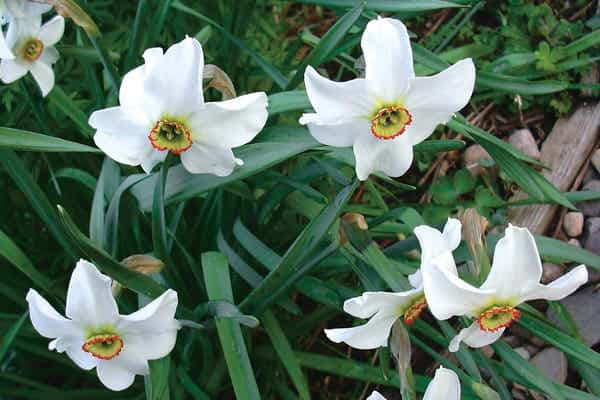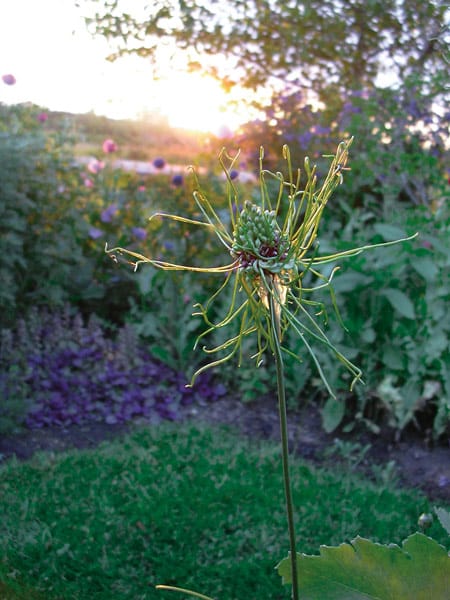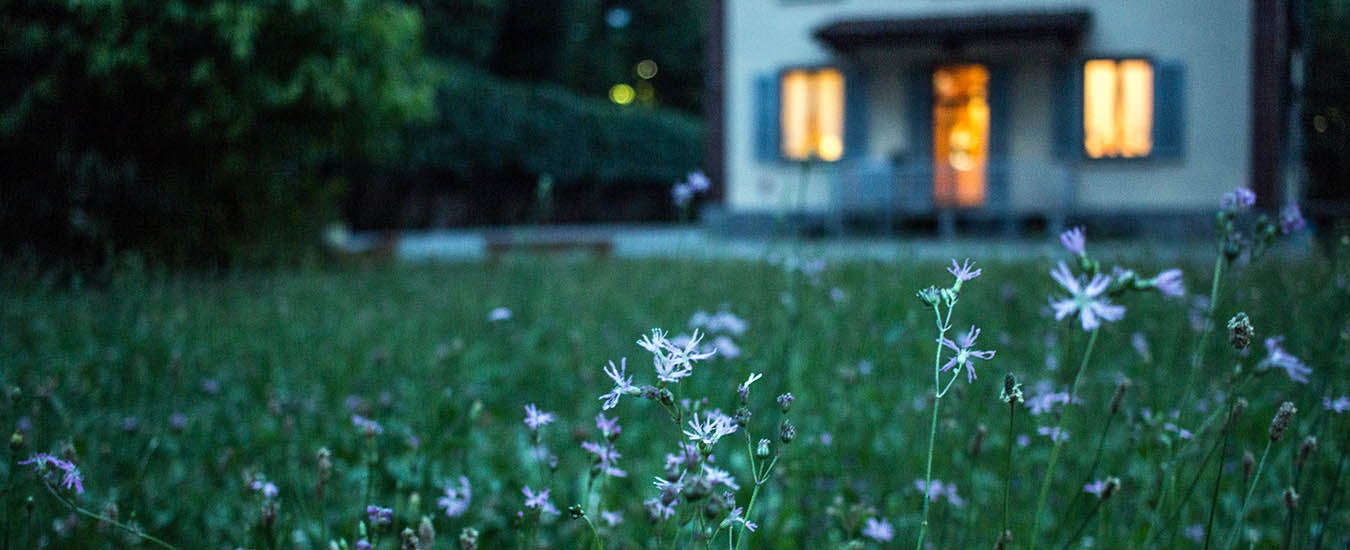>The Joy of Bulbs
Mix it up and move away from the old favourites when planting bulbs this fall.
Gardeners react to autumn in different ways. Some, weary after a season of planting, feeding, weeding, clipping, mulching, deadheading, harvesting; are content to put away the tools, ready the gardens for winter, and while away the cold months reading gardening magazines and seed catalogues. Others regard the imminent arrival of frost with about as much glee as they do income tax deadlines. But there’s a joy to autumn, because it’s time to plant spring-flowering bulbs.
Like most bulb enthusiasts, I do plant the usual collection of crocus, tulips and narcissus each fall—and each has almost unlimited combinations of colours, sizes, shapes—but there are many more varieties to explore out there. I urge other gardeners to try two categories. One is the small wonders—plants that may not be very large, but are enchanting to look at, to smell, and to watch form into colonies.
Others are the showstoppers—the big, flashy and unusual plants that catch the eye of even the most purple-thumbed Philistines.
Planting Recommendations
No matter what you decide to plant, there are secrets to making your spring garden a success.
Choose the largest bulbs you can find and avoid those that are soft or mushy. Some bulbs, like tulips, have a papery covering similar to an onion, which can become ragged and loose. This won’t hurt the bulb. Plant bulbs as soon as possible after you purchase them. In autumn, bulbs are dormant and won’t start growing until they have been subjected to a cold period. If the weather is still too warm to plant, store them in a cool, dry place to avoid their becoming mildewed or drying out. Everyone repeat after me: plant bulbs with the pointed end up! Planting them upside down may prevent them from flowering, as they waste precious energy trying to grow toward the light from the opposite direction. If you’re not sure which end is up, plant the bulb on its side. With our harsh winters, planting three times as deep as the bulb is long helps prevent frost damage.

You can put bulbs in using a dibber, or bulb planter, but if you have a large number to plant it’s easier to dig a larger hole to put groupings in, at different layers. Plant large bulbs like crown fritillaria at the deepest level, perennial tulips and narcissus a little higher, and small bulbs like muscari and snowdrops closest to the surface.
Whichever method you choose, remember to add compost, bone meal, or a prepared fertilizer formulated for bulbs. Water the soil thoroughly, particularly if it is dry, and after a hard freeze, cover with a thick mulch to protect the bulbs and keep them moist.
While some people persist in planting in rows like little soldiers, bulbs of all types look best when planted in asymmetrical clusters of uneven numbers (five, seven, nine) or groups of individual colours. One exception occurs when naturalizing daffodils or narcissus in a lawn or garden area. Some gardeners will toss bulbs out in the area to be planted, and simply plant them where they land. While they may appear sparse for several years, each season will see the clumps increasing in size so that in time you’ll be awash in daffodils.
Dealing with Pests
 As many gardeners know to their sorrow, deer and squirrels consider tulips a delicacy. Other bulbs such as daffodils and hyacinths apparently aren’t as tasty, so many people plant these bulbs on top of tulips as protection. Fritillaria are good at discouraging squirrels, as their bulbs emit a musky odour. You can also put down a screen of chicken wire after planting to prevent bulbs from being dug up before the ground freezes.
As many gardeners know to their sorrow, deer and squirrels consider tulips a delicacy. Other bulbs such as daffodils and hyacinths apparently aren’t as tasty, so many people plant these bulbs on top of tulips as protection. Fritillaria are good at discouraging squirrels, as their bulbs emit a musky odour. You can also put down a screen of chicken wire after planting to prevent bulbs from being dug up before the ground freezes.
So go ahead: order some flowering bulbs from a reputable mail-order company, or make selections at your local nursery or garden centre. But don’t just go for the old standards. They are lovely, but isn’t variety one of the spices of life?
Showstopping Selections
Alliums
The last spring flowering bulbs to bloom, (some wait until July in our Fundy garden), these onion-shaped flowers come in a cornucopia of colours, including rich blue (A. caeruleum), deep purple, green and silvery white. While not the prettiest, the most unusual has to be Allium “Hair”, a drumstick allium (A. sphaerocephalon) with spiraling green tendrils. Another allium relative which has recently been renamed by the powers that rename plants is Sicilian Honey Garlic, Nectaroscordum siculum. The flower is a cluster of greenish white bells with mauve striping, an attractive combination.
Camassia
Make sure these bulbs are planted in humus rich soil that is moist but never soggy. Whether you call the plant camassia, quamash or camas, it’s an eye-catching delight with spikes of lovely, star shaped flowers in shades of blue.
Eremurus
This is on my list of must-plants this fall, ever since I saw foxtail lily being grown at a local nursery. These easily reach 6 feet in height, with spires of blooms in shades of yellow, orange, and pink. Bear in mind that they are harvested commercially late in the season, so often will come as a later order from nurseries.
Fritillaria
It’s great to see these bulbs gaining in popularity. For dramatic colour, there’s Fritillaria persica, Persian Bells, with stalks of nearly black bell-like flowers reaching three feet tall. If you want brighter colour, try the Crown Imperials (F. imperialis) which also grow three to four feet tall, boasting yellow, orange or red flowers ringing a stem and plumed with deep green foliage. (Take note that these bulbs are expensive, ranging from $3-12 each, depending on availability. But when you see them in bloom they are worth the price.)
Lilies
You’ll often notice Asiatic, Oriental and Trumpet lilies offered for sale at the same time as tulips, daffodils and the species mentioned here. You can plant these wonderful flowers either in late fall or in early spring, but I prefer fall as the lilies will bloom earlier in the spring. The secret to success with lilies is to plant the fleshy bulbs immediately after purchasing, as they deteriorate more rapidly than other bulbs.
Small Wonders
While some think bigger is better, I like the small wonders, those little gems that make a large impact.
Chionodoxa
The scientific name is a mouthful, but the common name says it all. Glory-of-the-Snow is an early bloomer, producing abundant spikes of many lily-shaped flowers in blue, white and less commonly, pink.
Eranthis
The tiny yellow, buttercup like flowers are early arrivals, and will naturalize over time, but should be planted closely. Soaking the pea-sized tubers overnight before planting helps to bring good germination.
Fritillaria
An unusual and beautiful plant is the checkered fritillary, (F. meleagris) which truly does boast a delicate pattern of checks in the rosy purple or white nodding flowers. An equally charming and different relative is F. michailovski, which has burgundy bell shaped flowers tipped in gold.
Galanthus(snowdrops)
The first snowdrops in our gardens, bravely emerging in late March or early April, are cause for celebration. While these tiny bulbs are relatively expensive, over time they will form into attractive colonies.
Iris
These aren’t the huge, fancy irises of later in spring and summer. Tiny Iris reticulata, I. danfordiae and I. histrioides are barely out of the thawing soil before they are bursting into blooms of yellow, blue and purple, many with sparkling contrast colours on their petals. Some will naturalize, while others require replanting each year. Make sure to check with your garden centre for planting information.
Muscari
Gorgeous little clusters of blue or white flowers, sometimes called grape hyacinths, are deliciously fragrant troopers that naturalize quickly and seem to grow well in any soil. Along with the all white or all blue varieties, there are bicoloured muscari in two-tone blue or blue and white, or the rare but lovely yellow-flowered M. macrocarpum.
Scilla
Nodding, gentian-blue flowers show up well when planted with bright coloured early daffodils and tulips, and will naturalize over several years into substantial colonies.
Forcing Bulbs Indoors
One of the perfect antidotes to a nasty case of winter blahs is a pot of sparkling hyacinths, daffodils, tulips or other spring flowering bulb. With a little planning, you can fool bulbs into starting earlier than they do outdoors, and have spring flowers in your home even while an Atlantic winter is howling around the outside.
Select small, early flowering tulips, narcissus, daffodils, crocus or hyacinth, and pot them up in planting mix that will drain well. It’s best to plant only one type in a pot, so that the plants bloom together. Do not cover the bulbs entirely with potting medium, but leave them half-bare, with at least an inch of soil under their bases.
Bulbs need to be subjected to a cold treatment at 3-10°C before they will break dormancy and bloom. If you have a cold room, or perhaps an extra refrigerator, which you can also keep in total darkness, this works well. Make sure that cabbage and apples are not stored in the same area, as they release ethylene gas, harmful to flower bulbs. How long the bulbs are kept in cold treatment depends on the type of bulb, but you can expect at least 8-12 weeks.
Keep the soil damp, but not soggy, throughout the treatment period. When shoots begin to appear, move the pots into a warmer (15°C) and well lit room. Generally, blooms last longer if the room is under 20°C.
Many garden centres now sell bulbs which have already been cold-treated, and all you have to do then is plant the bulbs, put them in a cool but well lit room, and let nature do the rest. It will still take a number of weeks from planting to flowering, so be sure you allow enough time.
One thing to remember: once the bulbs have been forced into flowering once, they can’t be used again in this manner. Some will grow the next year if planted outdoors, but most people simply discard the bulbs and foliage into their compost.
